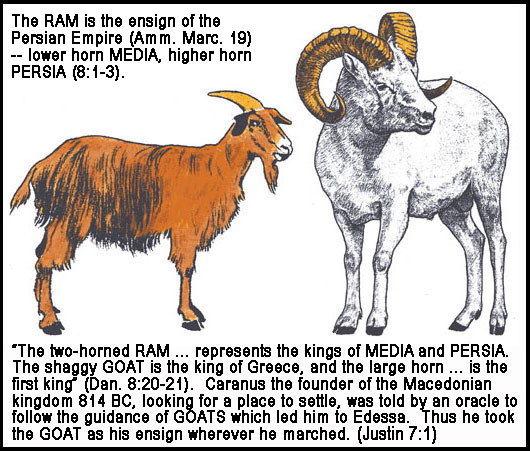
The RAM and the HE-GOAT!
Who were the Ram and the He-Goat of Daniel 8? Who was the great horn? Who were the four notable horns that took his place? Who was the little horn that became great? What are the stars that were cast to the ground? When did the 2300 days begin and end for treading down the sanctuary? What does God say about Muhammed, the Koran and Islam? (All Bible lessons are illustrated with color drawings).
There is indisputable evidence that the book of Daniel was written before the time of the events that it predicted. The Septuagint translation of the Old Testament (completed at the request of Ptolemy Philadelphus in the year 285 B.C.) antedates the historical period of the Maccabees by 120 years. (We use the historicist view of interpreting prophecy).
In 551 B.C., Daniel wrote in chapter 8:
1 In the third year of the reign of king Belshazzar a vision appeared unto me, even unto me Daniel, after that which appeared unto me at the first.
2 In my vision I saw myself in ... Susa in the province of Elam ... beside the Ulai Canal.
3 I looked up, and there before me was a ram with two horns, standing beside the canal, and the horns were long. One of the horns was longer than the other but grew up later.
4 I watched the ram as he charged toward the west and the north and the south. No animal could stand against him, and none could rescue from his power. He did as he pleased and became great.
5 As I was thinking about this, suddenly a goat with a prominent horn between his eyes came from the west, skimming across the whole earth without touching the ground.
6 He came toward the two-horned ram ... and charged at him in great rage.
7 I saw him attack the ram furiously, striking the ram and shattering his two horns. The ram was powerless to stand against him; the goat knocked him to the ground and trampled on him, and none could rescue the ram from his power.
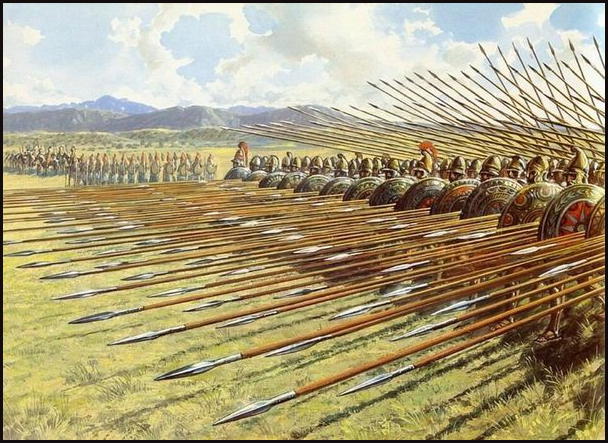
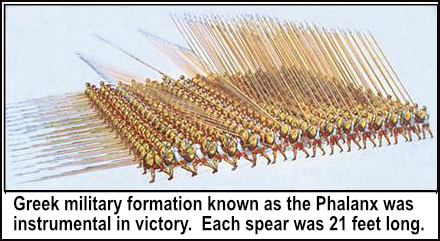
"The two-horned ram ... represents the kings of Media and Persia" (Dan. 8:20). Just as the bear raised itself on one side, so Cyrus the Persian overthrew the kingdom of his Median grandfather Astyages in 549 B.C. and Persia the younger kingdom, became greater. The higher horn came up last. The main direction of conquest for the Medo-Persian Empire was North (Upper Asia), West (Lydia) and South (Babylon and Egypt). There was very little expansion to the East, because of the mountains. "The shaggy goat is the king of Greece, and the large horn between his eyes is the first king" (8:21).
Victory over Persia, by the Greek kingdom began in 490 B.C. at the Battle of Marathon when Greeks defeated Persians. Then in 480 B.C. the Greeks gained a naval victory at Salamis and Xerxes (or Ahasuerus) returned to Asia, leaving a chosen army under Mardonius, which was destroyed by the Greeks at Platoea in 479 B.C. In this and the following years the Persians lost all their conquests in Europe, and many on the coasts of Asia. The goat's "notable horn" was the dynasty of Philip of Macedon, Alexander's father as well as Alexander's brother, Philip Aridoeus; and Alexander's posthumous son Alexander Aegus.
The goat's "notable horn" was Alexander the Great. The conquest of Persia was swift. Alexander's force was composed of 30,000 mobile cavalry. Alexander the Great had three special campaigns against the Medo-Persian Empire. The first was in Phrygia -- "the ram standing by the river" in 334 B.C. That river was the Granicus. The second in Cilicia at the Straits of Issus -- 333 B.C., and the third was Gaugemela or Arbela in 331 B.C. Alexander and the Greeks were furious with Persia for all the damage inflicted on Greece, including the burning of the city of Athens. Then Alexander pursued Darius. Finally he advanced NE through Afghanistan into India. He had designs for the subjugation of the whole continent of Asia, but the refusal of his soldiers to proceed, stopped him at the Sutlej, and forced him homeward.
The Ram and Goat Are Historically Appropriate. The Medo-Persians were accustomed to stamp a ram upon their coins, and therefore a ram is the most suitable symbol for them. The Ram emblem is still to be seen on the ruins of Persepolis. A ram is a large, male sheep just as the Medo-Persian army was large. Ammianus Marcellinus, a fourth century A.D. historian, states that, “When a Persian general or a Persian monarch stepped in front of his troops for a battle, he portrayed a ram somewhere on his attire.”
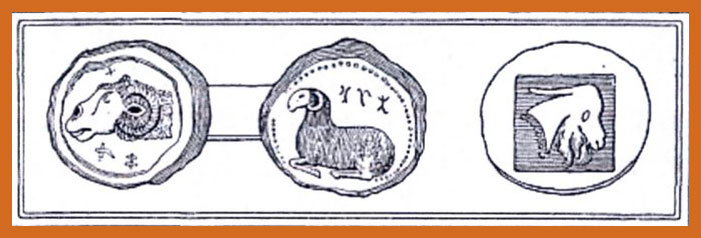
The Macedonians stamped a goat (notice only one prominent horn is apparent) upon their coins because about 200 years before the time of Daniel, their first king named Ceraunus, with a number of Greeks, sought to find a new habitation in Macedonia; and the oracle had told this king that he must be guided by a herd of goats. As they were traveling they came across a herd of goats that were fleeing before a violent storm. The king and the people followed these goats, and the goats led them to the city of Edessa, which he fixed as the seat of his Empire, taking the goat as his ensign and calling his city Aegea, "Goat's Town." Thus the people were called "The People of the Goats," Aegeadae, from the Greek word "aiyos," a goat. Therefore, the goat symbolized Greece. (See Justin 7:1 & Pliny Nat. Hist. 4:17)
Just as the goat "came close to the king" (8:6) so twice Alexander penetrated the center of the Persian army, where Darius was positioned. It was with extreme difficulty that Darius narrowly escaped from Alexander: such a close call that his chariot, lance and spear were taken, a first and second time.
In verse 8, The goat became very great, but at the height of his power his large horn was broken off, and in its place four prominent horns grew up toward the four winds of heaven.
When Alexander entered Babylon, and announced his intention of rebuilding its ruins and restoring its ancient gods, and making it the seat of his Empire, he suddenly and unexpectedly contracted a fever, and died. Why? Because God had said that Babylon would "never be inhabited" (Isaiah 13:19-22).
The "notable horn was now broken."After the sudden death of Alexander the Great in 323 B.C. due to Malaria fever, Philip Aridoeus his half-brother, was proclaimed king, and in conjunction with him, a posthunous son of Alexander's by Roxana called Alexander Aegus. But in 317 B.C. Philip was murdered, and in 310 or 309 B.C. Aegus and Roxana also were murdered. Whereupon the generals, who were not his family, all put crowns upon themselves and divided his empire between them. At the battle of Ipsus in 301 BC Antigonus, a fifth general, was defeated and killed by the other four. There were exactly four corresponding to the four leopard heads of Daniel 7:6. Lysimachus took Thrace, Cappadocia and Bithynia. Cassander got Macedonia Thessaly and Greece. Seleucus got Syria, Babylon, Media and the East. Ptolemy got Egypt Palestine, Cyprus, Arabia and Petraea. These were the "four winds of heaven." The empire of Alexander came under only four rulers in 290 BC and thus fulfilled Daniel 8:22. The two western divisions of the empire dropped out of view and only Ptolemy's Egypt and Seleucus's Syria remained. These latter two were the most powerful kingdoms and their position made Israel a pawn between them, it being periodically under the control of one or the other until the rise of the Romans.
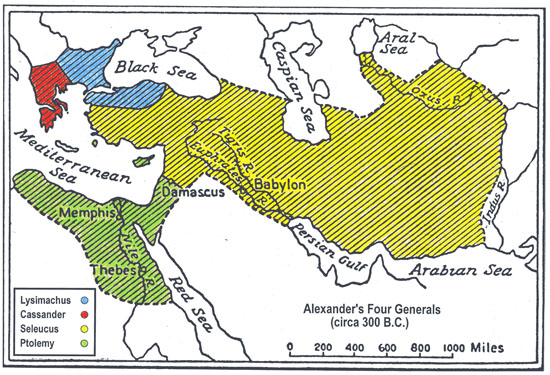
| "We are told there was brought to Pericles, from one of his farms, a ram's head, with only one horn; and Lampo the soothsayer observing that the horn grew strong and firm out of the middle of the forehead, declared that the two parties in the state, namely, those of Thucydides and Pericles, would unite, and invest the whole power in him with whom the prodigy was found." (Plutarch Pericl. 6) |
It was a Miracle that the High Priest was Spared by Alexander
The "notable horn" represents the first king of Greece (8:21). The first king of the Grecian Empire in Asia was Alexander the Great. He came from the west (8:5-8). That is, from Greece to Asia. He "touched not the ground" meaning he was very swift and sprang quickly like the leopard with four wings. Alexander's force was composed of 30,000 mobile cavalry. Alexander the Great had three special campaigns against the Medo-Persian Empire. The first was in Phrygia -- "the ram standing by the river" in 334 B.C. That river was the Granicus. -- the second in Cilicia (Straits of Issus) and the third was in Assyria (Gaugemela or Arbela). Before Alexander began the Battle of Arbela, he had conquered Gaza and was on his way to Jerusalem when he was hindered by a very wonderful incident.
Josephus' Antiquities 11:8:4 says, "Alexander, having destroyed Gaza, hastened to ascend to Jerusalem. Jaddua, the high priest, learning this, was alarmed and terrified, as he knew not how to meet the Macedonian king, irritated by his former disobedience. He therefore ordered the people to make their supplications, and sacrificing to God, besought Him to protect the nation and deliver it from impending danger. God appeared to him in a vision, as he was sleeping after the sacrifice, and told him to be of good cheer, to crown the city with garlands, to throw open the gates, to go forth to meet the Macedonians, with all the priests in their sacerdotal robes, and with the people in white garments, and not to fear, as God would provide for their defense.
"The High Priest rose from sleep, and rejoicing in spirit, communicated the divine message to the people. He then performed all that he was commanded to do and awaited the arrival of the king.
"On learning his approach to the city, he went forth attended by the priests and people, so as to give the procession a sacred character, distinct from the habits of other nations. The spot where the meeting took place was at Sapha, or the Watch-tower, so called because Jerusalem and the Temple are thence visible. But the Phoenicians and Chaldeans who followed the king, and expected him in his anger to allow them to plunder the city and put the high priest to death, with every species of torture, witnessed a far different scene.
"For when Alexander from a distance saw the multitude in white garments, and the priests in front with their variegated robes of fine linen, and the chief priest in his hyacinthine dress, embroidered with gold, and bearing on his head the golden diadem, on which was inscribed the name of God; he advanced alone, prostrated himself before the holy name, and was the first to salute the high priest. But, when the Jews with one voice had saluted and encircled the king, the Syrian kings and the rest of his retinue began to doubt the soundness of his intellect. They ventured to draw near and ask, 'Why he, before whom all prostrated themselves, paid that honour to the high priest of the Jews?' He answered, 'I did not prostrate myself before him, but before the God with whose priesthood he has been honoured. For while I was yet in Macedonia, I saw him in the same dress in my dreams. And as I was deliberating in what manner I should conquer Asia, he exhorted me not to hesitate, but to cross over with confidence, as he would be a guide to the expedition and deliver the Persian Empire into my hands. As, therefore, I have seen no other in similar dress, as this spectacle reminds me of the vision in my sleep, and of the exhortation, I conclude that my expedition was undertaken under Divine Providence, that I shall conquer Darius, put an end to Persian domination and succeed in all my plans.'
"After this explanation, Alexander took the high priest by the right hand and entered the city, while the people ran along on both sides. He then went up to the Temple and sacrified to God according to the directions of the High Priest, and highly honoured both him and the other priests. Then the Book of Daniel and the prediction that a Greek was destined to overthrow the Persian Empire, were shown to him. From it he concluded that he was the person signified, and being much delighted, dismissed the multitude for the present; but the next day he called them to him, and bade them ask what favors they pleased of him; whereupon the high priest desired that they might enjoy the laws of their forefathers, and might pay no tribute on the seventh year. He granted all they desired."
If the Macedonians were of Hebrew origin and Alexander of Israelite descent, we find yet another reason why he so speedily granted their desires. The prefix "mace" signifies "great." Macedonians means great Donians, or Danites. The conquests of Alexander not only humbled Israel's oppressors, but caused the Greek language to be spread abroad which helped the circulation of the New Testament.
Did Alexander Die Because He Tried to Rebuild Babylon?
The verse says, "when he was strong the great horn was broken." Alexander had only reigned twelve years and was at the zenith of his power. He was marching with the intention of conquering Babylon and making it a city of his empire. While he was on his way to Babylon, some of the Babylonian priests met him and told him that, they had been informed by their oracle, that if he entered into Babylon some great disaster would happen to him. Not that they feared Alexander the Great, nor had they any dislike to his rule: they were very glad of the change of monarchy. The Medes and Persians had overthrown the ancient gods of Babylon, and Alexander the Great intended to restore them. For although Alexander bowed before the High Priest in Jerusalem, he was one of those people who would bow before any religion, and any god, who could serve him for the time being. And therefore the Babylonians were well pleased that he should take the city of Babylon. But they warned him of this oracle. However, Alexander, all the same, entered Babylon, and announced his intention of rebuilding its ruins and restoring its ancient gods, and making it the seat of his Empire. But, suddenly and unexpectedly, he contracted a fever, and died very quickly (324 B.C.). Why? The prediction for Babylon was that it would "never be inhabited" (Isaiah 13:19-22)? "Now the horn being broken, whereas four stood up in its place, four kingdoms shall stand up out of the nation, but not in his power." After the sudden death of Alexander the Great due to Malaria fever, his sons for about fifteen years, kept up a show of government, but eventuallty they were murdered, and the whole family cut off. His natural brother and two sons were murdered. And then his successors, who were not his family, divided his empire between them. At the battle of Ipsus in 301 BC Antigonus was defeated and killed by the other four. There were exactly four. Lysimachus took Thrace and Bithynia. Cassander got Macedonia and Greece. Seleucus got Syria, Babylon and the East. Ptolemy got Egypt Palestine, Arabia and Petraea. The "four winds of heaven." The empire of Alexander came under only four rulers in 290 BC and thus fulfilled Daniel 8:22. The latter two were the most powerful kingdoms and their position made Israel a pawn between them, it being periodically under the control of one or the other until the rise of the Romans.
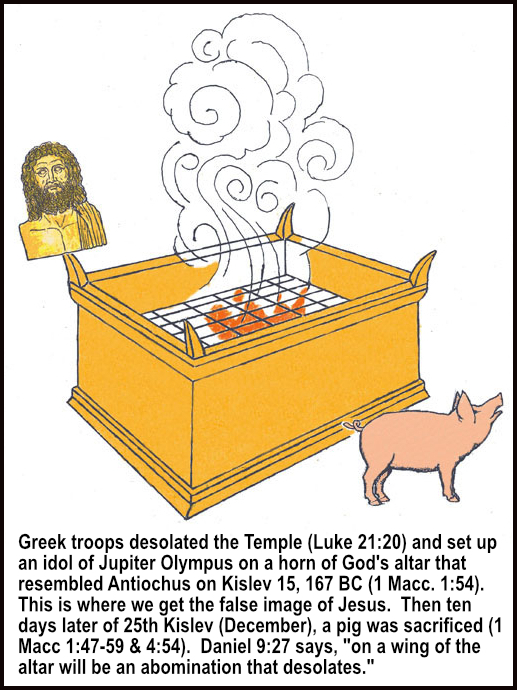
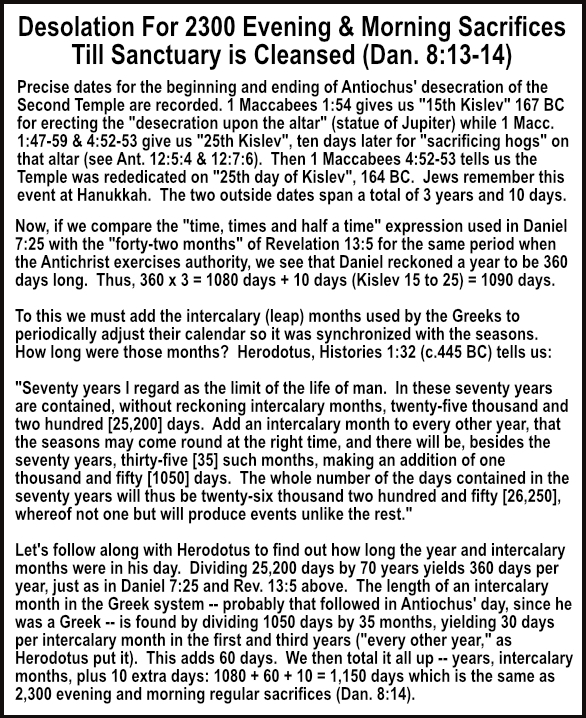
1. Antiochus Epiphanes Was The Greek "Little Horn" Fulfilment of Daniel 8
8 The goat became very great, but at the height of his power his large horn was broken off, and in its place four prominent horns grew up toward the four winds of heaven.
There were exactly four corresponding to the four leopard heads of Daniel 7:6. Lysimachus took Thrace, Cappadocia and Bithynia. Cassander got Macedonia Thessalyand Greece. Seleucus got Syria, Babylon, Media and the East. Ptolemy got Egypt Palestine, Cyprus, Arabia and Petraea. These were the "four winds of heaven." Antiochus came from the Seleucid horn of this Greek Empire; and Titus the Roman general may have also come from one of the Greek horns. It is interesting that Diocletian divided the Roman Empire into four parts called prefectures. They were 1.) the East, 2.) Illyricum, 3.) Gaul and 4.) Italy (Rev. 6:8). Mohammed came from the Eastern horn of this Roman Empire.
9 Out of one of them came another horn, which started small but grew in power to the south and to the east and toward the Beautiful Land.
At this point in the prophecy, there are at least FOUR fulfillments. Antiochus Epiphanes, Roman Generals Cestius and Titus, both the Arab and Turkish Moslem Caliphates, and the Roman Catholic Papacy. Let's deal first with Antiochus.
Antiochus Epiphanies, who reigned from 176-164 B.C. Antiochus expanded his empire south toward Egypt, east towards Babylon and Persia, and towards Palestine (In the Hebrew, the term "Glorious Land" is used for the land of Israel in Ezekiel 20:6 (the glory of all lands), Ezekiel 25:9 (the glory of the country), and in Daniel 11:16 and 11:41. Similar wording is used in Psalm 48:2.). Furthermore, when Antiochus entered the Jerusalem Temple court, he put an idol of Jupiter Olympus with his own likeness on one of the four horns of the brass altar -- which also fulfills this prophecy. .Within a year of the death of the Prophet in 632 A.D., Abu Bakr, the first Caliph, brought the whole Arabian peninsula under the sway of Islam -- SOUTH. In the following year he overran Mesopotamia, and attacked Persia in the EAST, but returned in 634 to invade Syria and Palestine, "the GLORIOUS LAND," capturing Jerusalem in 637 (Gibbon 5, pp. 297-328).
10 It grew until it reached the host of the heavens, and it threw some of the starry host down to the earth and trampled on them.
Antiochus tramples on Jews. First Maccabees 1:29-32 and 1:52-61 describe how Antiochus persecuted the Jews. Titus trampled on Jews. One million Jews perished by famine and sword. Ninety thousand were sold into slavery (Wars 5:12:4) Islamic Caliphs trampled on Jews and Christians. Although at first Christians themselves were not put to death, Gibbon informs us that during the ten years of the administration of the second Caliph, Omar (634-644 A.D.), four thousand churches or temples were destroyed (prayer and preaching were therefore the sacrifices taken away) and everything possible was done to humiliate Christians. For example, as signs of their degradation, they were made to wear "a turban or girdle of less honourable color; instead of horses or mules, they were condemned to ride on asses in the attitude of women. Their public and private buildings were measured by a diminutive standard; in the streets or in the baths it was their duty to give way or bow down before the meanest of people.
11 It set itself up to be as great as the Prince of the host; it took away the daily sacrifice from him, and the place of his sanctuary was brought low.
"Then the king... on the fifteenth day of Chislev erected a dreadful desecration upon the altar" (1 Macc. 1:41-54). He erected an idolatrous altar on the altar of the Temple (Ant.12:5:4; 12:7:6). Identifying himself with Jupiter, he sacrificed a pig to Jupiter Olympus and sprinkled pig's blood in the Holy of Holies "on the twenty-fifth of the month" Chislev (1 Macc. 1:59; 1 Macc. 4:54). He came before Christ's first coming just as the Anti-Christ will come before Christ's second coming (Matt.24:15). The desecration took place on the 15th of Chislev. The pagan sacrifices began on the "five and twentieth day of the ninth month" (1 Macc.4:54).
We have seen three "ABOMINATIONS that DESOLATE" so far. As our Lord said, "when ye shall see Jerusalem compassed with ARMIES, then know that its DESOLATION is near" (Luke 21:20). The Greek armies of Antiochus who took away the Temple furnishings, broke them in pieces and carried them off to their own country; the Roman armies of Titus that burned Herod's Temple to the ground; and the Moslem armies of Caliph Omar that built the Dome of the Rock in the place where the temple once stood. In addition to the physical destruction that each army caused, we know that Antiochus Epiphanes sacrificed a pig to Jupiter Olympus and sprinkled PIG'S blood in the Holy of Holies (1 Macc.6:7; 2 Macc.6:2). The Roman legions carried their standards, the EAGLE and the SERPENT (both unclean) into the Temple and sacrificed before them in the traditional Roman manner -- an ox, a sheep, and a PIG (unclean) -- hence ABOMINATION. The Moslem Dome of the Rock enshrines a rock in the center of the dome. This is the spot from which MUHAMMAD supposedly ascended for a night-long journey to heaven in AD 621, accompanied by the angel Gabriel. There he supposedly met many prophets like Abraham and Moses and was given the Islamic prayers before returning to Earth. It is interesting that when Greece controlled Syria (331 B.C.), there was a Greek abomination soon after (168 B.C.). When Rome controlled Syria (63 B.C.), there was a Roman abomination soon after. When Moslems controlled Syria (638 A.D.), there was a Moslem abomination soon after (638 A.D.). Therefore, the abomination always came from the power controlling Syria.
Some commentators believe that Idumean Herod the Great who became "King of the Jews" was the one who "magnified himself against the Prince of the host" (v. 11), by seeking to slay our Lord at birth, as his son, Herod Antipas, "magnified himself" by presuming to sit in judgment upon Jesus before His crucifixion.
12 Because of rebellion, the host of the saints and the daily sacrifice were given over to it. It prospered in everything it did, and truth was thrown to the ground.
In Antiochus' day, many from Israel offered sacrifice to idols and broke the sabbath and profaned the festivals. They ate unclean food and didn't circumcise their sons. Antiochus sold the Priesthood of the Jewish Temple to the highest bidder -- to Menelaus of the tribe of Benjamin, who was willing to introduce Greek culture to Jerusalem. Many in Israel adopted Hellenistic customs, erecting theaters and gymnasiums where Jews exercised naked (1 Macc. 1:11-16) and regarding all religions as alike. Josephus Antiquities Book 12, chapter 5, verse 4 mentions that any Bibles found were burned.Then Maccabeus and others decided they would strike a blow and defeat the forces of Antiochus Epiphanes. In 164 B.C., after earnest prayer, they gained a great victory with only 10,000 Jews against 65,000 Greeks under the command of General Lysius. After that victory they were able to cleanse the Temple. Maccabeus and his followers recovered Jerusalem and restored the daily sacrifice. To commemorate their victory they instituted the "Feast of Dedication" (John 10:22) -- also known as Hannukah.
13 "How long will it take for the vision to be fulfilled—the vision concerning the daily sacrifice, the rebellion that causes desolation, and the surrender of the sanctuary and of the host that will be trampled underfoot?"
14 He said to me, "It will take 2,300 evenings and mornings; then the sanctuary will be reconsecrated."
What is an evening and morning? The evening and morning were the first day Gen 1:5. The evening and morning were the second day Gen 1:8. And, so twenty three hundred evenings and mornings can be 1150 days!
Some commentators try to find 2300 days from the time of "the little horn waxing great toward the pleasant land" and "casting down some of the host" (8:9-10) -- from Sivan 171 B.C. when Onias III the legitimate high priest was murdered and a pseudo line of priests assumed power and the sacrifices began to be neglected owing to the high priest Jason introducing at Jerusalem Grecian customs and amusements such as the palestra and gymnasium (2 Macc. 4:7-14) and ending with the death of Antiochus in 164 B.C. during a military campaign in Media. This was about six years and three months (six years and 110 days.) or approximately 2,300 literal days. His death permitted the cleansing of the sanctuary and the return of Jewish worship. Both the rebellion and the stopping of the daily sacrifice are included in this time period (Dan. 8:13-14). Many note that the prophecy includes the attack on the land and "the prince of the host," or high priest.
But it is more likely that the period being asked about dates from the taking away of the daily sacrifice until it is restored (see ASV & NIV).
From the taking away of the daily sacrifice until the restoration of the sacrifice is to be 2,300 evenings and mornings. Since the sacrifice was offered, one in the evening and one in the morning, it is just as natural to view the prophecy as comprising 1150 days which would contain 2,300 sacrifices.
Josephus called this period "three years and six months" in Wars 1:1:1-2 and "three years" in Antiquities 12:7:6. First Maccabees is more precise. First Maccabees 1:54 says: "On the 15th day of the 9th month of the 145th year [of the kingdom of the Greeks] king Antiochus set up the abominable idol of desolation upon the altar of God." The termination is established in the same book I Maccabees 4:52,53 "And they arose before the morning of the 25th day of the 9th month of the 148th year, and they offered sacrifices according to the law upon the new altar."
Herodotus in 445 B.C. recorded a conversation between Solon and Croesus, a Greek king in Asia Minor. He wrote in 1:32: "Take seventy years as the span of a man's life. Those seventy years contain 25,200 days without counting intercalary months. Add a month every other year to make the seasons come round with proper regularity, and you will have 35 additional months which will make 1050 days. Thus the total days of your seventy years is 26,250 and not a single one of them is like the next in what it brings." From this passage we see that the length of the Greek year is 25,250 divided by 70 or 360 days. This would have been the year to Solon, Croesus, Herodotus, and most likely to Antiochus Epiphanes and the Maccabees. Further observation we can see that 1,050 days divided by 35 gives 30 days as the length of the intercalary month.
The Julian Calendar using a 365-day year was not in official use until 45 B.C. The calendar in use when the prophecy was fulfilled was different from that in use today. This prophecy was fulfilled about 165 years before Christ. The lunar calendar of the earliest Greeks had 354 days. But that was too early. We must use the 360-day calendar of the Hebrews and Greeks at the time of the Maccabees. Using the Greek calendar according to Herodotus 1:32 (who wrote in 445 B.C.) and assuming that the years 146 and 148 were intercalary years, we come up with the following calculation: 9-15-145 to 9-25-148, the dates given in Maccabees from the desecration to the cleansing, is three years and ten days. Thus, the math sentence following the Greek calendar which was in use at the time the prophecy was fulfilled would be: 1080 days (3 X 360) + 60 days (2 X 30 intercalary months) + 10 days (from the 15th to 25th) = 1150 days total. This was the "Great Tribulation" which lasted for three and one half years, and which the faithful Jews went through from 167 to 164 B.C. This vision which foretold these events must have been a cause of very much comfort to the people who lived in Jerusalem. The 2300 "days" that the sanctuary was defiled actually refer to "evenings and mornings" (Dan. 8:26). In most Bibles, Daniel 8:14 says "days" but the margin reads "evening-mornings" because the daily sacrifices were offered evenings and mornings (see Lev. 6:9,12). The Revised Standard Version correctly reads, "For two thousand and three hundred evenings and mornings." In other words, here is a prophecy that 2,300 evening and morning sacrifices would cease to be offered, or a period of 1,150 days. This occurred from 167 to 164 B.C. -- a type of what was yet to occur on a greater scale.
When Antiochus demanded that the Jews worship him as a "god," the Jews revolted (167 B.C.). The revolt for religious independence was led by an old man named Mattathias and his five sons. The sons, led by Judas Maccabaeus (meaning "the Hammer"), fought the Syrian army occupying Jerusalem and defeated them against enormous odds in 164 B.C. The Jews reconquered the temple site on the 24th day of the ninth month exactly three years to the day after the evil King Antiochus IV had sacrificed a pig for the first time on the altar. The next day, "Early in the morning on the twenty-fifth day of the ninth month of Chislev ... they rose and offered sacrifice, as the law directs, on the altar of burnt offering which they had built. At the very season and on the very day that the Gentiles had profaned it, it was dedicated with songs" (1 Macc.4:52-54). JewishTalmudic legend says that a one-day supply of the sacred oil was found hidden away in a wall of the Temple by a priest. When this was brought out to be used to light the lamp, it miraculously lasted for the full eight days of the celebration, until new oil could be made.
On the day before the Feast of Hanukkah, on the 24th of Chislev, there have been at least two other significant events in Israel's history. One was when the foundation for the second Temple was laid in 520 B.C. "From the four and twentieth day of the ninth month, even from the day that the foundation of the Lord's temple was laid, consider it.... From this day I will bless you" (Hag.2:18-19). Jerusalem was also freed from Turkish rule (another Abomination that desolated) , which lasted almost 400 years until World War 1, on December 9, 1917, the 24th of Chislev. The Turks gave up the city without a shot being fired thinking that "Lord Allenby" was a fulfillment of a prophecy of a "Man of Allah" (Allen - Allah, Beh - man). Today, this "Feast of Dedication" or "Feast of Lights" is commemorated for eight days beginning on the 25th of Chislev. Jesus Christ celebrated this festival (John 10:22-23).
Skipping to verse 23 "In the latter part of their reign, when rebels have become completely wicked, a stern-faced king, a master of intrigue, will arise.
Antiochus Epiphanies appeared toward the end of the Greek Seleucid control over Jerusalem. Most of Israel accepted Antiochus except for those who went into hiding and revolted with the Maccabees. Antiochus was diabolical betraying his brother and his sons, who saved him from the Romans. Antiochus was a master at deceit and manipulation. He is the forerunner of the final Antichrist, standing in the same relation to the first advent of Messiah that Antichrist will to the second coming. Antiochus IV legitimized his rule mainly through flattery and bribery.
24 He will become very strong, but not by his own power. He will cause astounding devastation and will succeed in whatever he does. He will destroy the mighty men and the holy people.
The Greek Orthodox Church obeys the Patriarch of Constantinople, who is not powerful like the Pope, but has to lean on the Emperor of Russia.
25 He will cause deceit to prosper, and he will consider himself superior. By peace, he will destroy many and take his stand against the Prince of princes. Yet he will be destroyed, but not by human power.
King Antiochus (175-163 B.C.) "came up to Jerusalem in 168 B.C., and pretending peace, he got possession of the city by treachery: at which time he spared not so much as those that admitted him into it" (Ant. 12:5:4). He entered the temple and "took away the golden altar and the candlestick of light" and other temple furnishings, broke them in pieces, and carried them off to his own country.When Antiochus demanded that the Jews worship him as a "god," the Jews revolted (168 B.C.). Antiochus started to force the people to worship and sacrifice to Zeus. Temple sacrifices were stopped, and an image of himself, pictured as Zeus was placed in the Jewish Temple on the 15th of Chislev (corresponding to our December 25th celebration when most churches put an image of a long-haired Zeus-like savior on a cross in their churches and worship a tree by giving it presents). Antiochus set up an image in the Temple and proclaimed himself god, he demanded to be worshiped. 1 Maccabees 1:41-50 describes his blasphemies. He is the forerunner of the final Antichrist, standing in the same relation to the first advent of Messiah that Antichrist will to the second coming. Antiochus IV legitimized his rule mainly through flattery and bribery. Antiochus named himself “Epi Phanes” or god manifest. He proclaimed himself as Zeus manifest in the world. The Jews used a play on words and called him “Epimanes” meaning lunatic. Calling himself god, he exalted himself as the Prince of the host. The coins of Antiochus Epiphanes were inscribed with this title: "theos epiphanies" meaning, "God manifest." The coming Antichrist will also exalt himself: So that he sits as God in the temple of God, showing himself that he is God (2 Thessalonians 2:4).
About 170 B.C. Antiochus Epiphanes began preparations against Jerusalem. He besieged and took the Holy City, and slew about 40,000 Jews with the sword.
A short time after the Jewish victory in 164 B.C., Antiochus Epiphanes, who was then in Persia, received the news of the Maccabean victory and was filled with wrath, and declared he would march against Jerusalem immediately, level it to the ground, and slay every Jew he could find there. But on his way he was seized with a fearful and loathsome disease and was eaten by worms -- he was "broken without hand."

2. General Titus was the Roman "Little Horn" Fulfilment of Daniel 8
Daniel 8:11 describes the Roman crucifixion of Jesus. Rome stood up against the Prince of princes in 31 AD. Jesus warned of a coming "abomination of desolation spoken of by Daniel the prophet, standing in the holy place" (Matt. 24:14-16). He spoke almost 200 years after Antiochus died in 164 B.C. Therefore we know there is more than one. In the immediate future, the Roman Abomination of Desolation was the armies of Titus in 70 A.D. The Moslem Abomination of Desolation was the army of Omar in 627 A.D. There will no doubt be an end-time Abomination also. Titus the Roman general actually tried to save the temple (Josephus, Wars 6:2; 5:12) but his soldiers -- "the people of the prince" destroyed it on the ninth of Av (August) putting an end to sacrifices. It may have then taken as many as six or seven months for Titus to send the survivors as slaves into Egypt and the other provinces (Wars 6:9:2-3) bringing us into 71 A.D., exactly 40 years after 31 A.D.
God gave a generation of 40 years to repent from A.D. 26-27 to 66-67 and 31 A.D. until 71 A.D. Herod's Temple was destroyed on 9 Av (August 4, 70 A.D. on the Julian calendar) by the Romans. The Babylonian Talmud records that for 40 years before the Temple was destroyed, the following events occurred: The lots for the Yom Kippur goats ceased to be supernaturally determined; the crimson thread tied to the Azazel goat's horn (which had before supernaturally changed to white to show God's forgiveness) remained red; the western candle in the menorah in the Temple sanctuary would not burn continually; and the doors of the Temple would open by themselves (Yoma 39b). The gospel was preached to every man and woman of Judah in all the earth (Rom. 10:18). In the last week of September and in the first week of October of 66-67 A.D., the Roman army under Cestius reached and surrounded Jerusalem exactly 40 years from the time Jesus public ministry had begun in Judea. "Forty years long was I grieved with this generation" (Ps. 95:10; cp. Heb. 3:30). Soon there was fighting about the temple itself. The Romans "attempted to break into the temple at the northern quarter of it; but the Jews beat them off from the cloisters." The cloisters were parts of the temple buildings. The Roman soldiers then placed their shields together in "tortoise-back" formation to protect themselves from darts shot from the wall above and"undermined the wall and got all things ready for setting fire to the gate of the temple" (Josephus' Wars). Jesus had warned his disciples, "When ye therefore shall see the abomination of desolation, spoken of by Daniel the prophet, stand in the holy place ... then let them which be in Judea flee into the mountains: let him which is on the housetop not come down to take anything out of his house: neither let him which is in the field return back to take his clothes.... But pray ye that your flight be not in the winter, neither on the Sabbath day" (Matt. 24:15-20). Roman standards around the temple itself were a signal to Christians to flee. Those in the fields or villages round about could easily do so; but how could those in the city escape, with the Roman army encompassing the walls? Josephus says that just as Cestius had the wall undermined and all in readiness for the attack, suddenly "he recalled his soldiers from the place, and by despairing of any expectation of taking it, without having received any disgrace, he retired from the city, without any reason in the world" (Wars 2:19). As the Jews rushed out to attack the retreating Romans, the brief moment and the opportunity for the flight of the Christians had come. Though the next siege was deferred four years, the time for flight was that day when the Jewish forces rushed from the city. As the fanatical Zealots came back exulting from slaying the rearguard of Cestius's army, they came to take possession of affairs in Jerusalem, and to organize every force for the next attack. Christian believers attempting to get away then would have met no mercy. The Zealots created and maintained a "reign of terror."
Christians escaped into the mountains across the Jordan, as they had been forewarned by Jesus to "flee" when they saw Jerusalem compassed with armies. For four years the war flowed over Judea. At the time of the Passover, A.D. 70, the Roman Prince Titus, son of Vespacian the Emperor, reached Jerusalem with his army and immediately proceeded to lay siege to the city. This was 39 years to the day from the time the Jews crucified Jesus. Within a month the Romans had built their siege works completely around Jerusalem so that none could escape. In June the assault began and on August 4th, A.D. 70, the Romans captured the lower city and set fire to the temple. At the end of August the rest of the city was captured and set on fire. Titus tried to persuade the Jewish leaders to save the temple by saying, "I do not force you to defile this your sanctuary; and if you will but change the place wherein you will fight, no Roman shall either come near your sanctuary nor offer any affront to it; nay, I will endeavor to preserve you your holy house whether you will or not" (Wars 6:2). Later Titus "called God to witness that this (temple destruction) was not his doing" (Wars 5:12). After the city fell, and Titus had examined the walls and towers, he exclaimed, "We have certainly had God for our assistant in this war and it was no other than God who ejected the Jews out of these fortifications" (Wars 6:9). When Christ foretold the coming destruction, even his disciples exclaimed about these same fortifications, "Master, see what manner of stones and what building are here!"
Over 1,100,000 of Judah perished by famine, disease and the sword of the Romans (Josephus' Wars 6:9:3). The destruction of both the first and the second temple were both as a result of the people’s rejection and disobedience to God. Jesus had warned the Jews before his death that because they rejected him as Messiah, the Kingdom of God would be taken from them and given to another nation bringing forth fruits of obedience (Matt. 21:23), that because the Jews had killed his son and his servants (the apostles), God would send forth his armies to destroy their nation and burn their city (Matt. 22:1-8) and "your house is left unto you desolate" (Matt. 23:28) and "not one stone would be left standing upon another" (Matt. 24:2). Jesus then defined what the "abomination of desolation" standing "in the holy place" was in Luke 21:20: "When ye shall see Jerusalem compassed with armies, then know that the desolation thereof is nigh" referring back to Daniel 9:26-27 and the army "flood" and "war" that desolates. The Jews had rejected God's hen wings of protection (Matt. 23:27) and so now accepted Rome's eagle wings of destruction and abomination (Dan. 9:27).
From December 31st 67 A.D. when Cestius withdrew his Roman legions until July 31st 70 A.D. was 1,290 days exactly, as God had given them ample warning through Daniel and Yeshua to escape. Then from July 31st 70 A.D. when the Romans returned under Titus, another 45 days of total ruin and destruction came to Jerusalem as 225,000 Jews lost their lives in the war. And finally 76 months later or “2,300 days until the sanctuary shall be cleansed” (Daniel 8:14), on May 20th 73 A.D., when the Jewish government and all of the territories of Israel were sold off.
The stone-built Temple at Jerusalem, was then superseded by a “new living stone temple” as the Apostle Paul spoke of in Ephesians 2:19-22. He referred to the body of Messiah as the “holy temple” and the Apostle Peter called them “lively stones” (1 Peter 2:5). This fulfilled the prophecy of Daniel 8:14 of the sanctuary being cleansed, because God had replaced the physical temple and animal sacrifices (which never did atone for sin in the first place), with the living temple of the believer, “cleansed” with the blood of the Lamb and “sanctified” by the Holy Spirit.
3. The Moslem Caliphate was the Arab-Turkish "Little Horn" Fulfilment of Daniel 8
Upon Muhammad’s death in AD 632, the four Caliphs assumed leadership of the Islamic people. Known as ‘the Rightly-Guided Caliphs,’ the four Caliphs were: Abu Bakr, Umar, Uthman, and Ali. They ruled for nearly 30 years following the death of Muhammad. After the first four caliphs, the religious and political authorities in Islam were never again united under one institution. Most Muslims would know four sets of belief and practice in their religion: Hanafi, Maliki, Shafi'i and Hanbali.
There were four Sultanates of Turks bordering on the Euphrates corresponding to the four angels and four horns of the brass altar (Rev. 9:13-14) (or belly and thighs of brass). They were Baghdad, Damascus, Aleppo, and Iconium. They correspond to the "four notable horns" (Dan. 8:8,22). The Turkish Caliph came from Baghdad. Turks came from Chorassan -- the Seleucid horn. Togrul Beg of the Seljukian Dynasty made his capital at Seleucia which he called Bagdad. It is a strange coincidence that Istanbul's freshwater estuary that is the commercial heart of the European side of the city -- the principal harbour for 2000 years -- has a western name of "Golden Horn."
9 Out of one of them came another horn, which started small but grew in power to the south and to the east and toward the Beautiful Land.
Just as the western "little horn" of Papal Catholicism grew out of Rome -- the pagan Roman Empire, so also the eastern "little horn" of the Moslem Arab Caliphate grew out of the pagan Greek Empire. Mohammed and Islamic Arabs came from Mecca and Medina in Arabia and built Bagdad where Seleucia had been. Possessed at first of little temporal authority, like the bishop of Rome, yet by assuming spiritual authority it soon became exceedingly great. The little horn "grew exceedingly great toward the south, toward the east, and toward the glorious land" (8:9) Within a year of the death of the Prophet in 632 A.D., Abu Bakr, the first Caliph, brought the whole Arabian peninsula under the sway of Islam -- SOUTH. In the following year he overran Mesopotamia, and attacked Persia in the EAST, but returned in 634 to invade Syria and Palestine, "the GLORIOUS LAND," capturing Jerusalem in 637 (Gibbon 5, pp. 297-328). Subsequent expansion was rapid, and Gibbon says of Mohammed that, "One hundred years after his flight from Mecca, the arms and reign of his successors extended from India to the Atlantic Ocean, over ... Persia, Syria, Egypt, Africa and Spain."
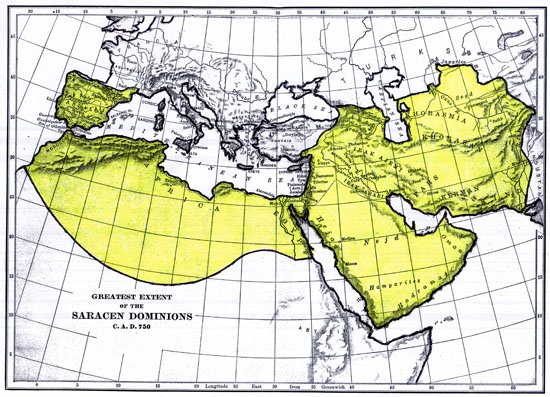
10 It grew great, even to the army of heaven; and some of the army of the stars it cast down to the ground, and trampled on them.
The army of heaven must be the Christian Church, and the stars must represent Christian leaders because they are interpreted as "the mighty ones and the holy people" (Dan. 8:24). The mollahs of Mohammed replaced the ministers of idolatrous Greek Christianity. Thus the prophecy accurately describes the hostile attitude of Moslems to the Christian communities that remained within their their conquered territories. He caused the ruling authorities to be overthrown or "the stars to fall." The phrase "stars of heaven" (Genesis 12:3, 15:5) and "the hosts of the Lord" (Exodus 12:41) are used of God's people in general. Stars are people who shine or stand out. The descendents of Abraham were called stars in Genesis 15:5 and 22:17. Daniel 12:3 refers to those who lead many to righteousness as “Stars” who will shine.
This goat horn "set itself up to be as great as the Prince of the army of heaven, or "Prince of princes" -- 8:25 (Christ); it took away the daily sacrifice from him, and the place of his Temple was profaned" (Dan. 8:11).

Just as Muhammed took the place of Jesus Christ our Lord, so the Moslem Dome of the Rock occupied the place where the temple once stood. The Moslem Dome of the Rock enshrines a rock in the center of the dome. This is the spot from which MUHAMMAD supposedly ascended for a night-long journey to heaven in AD 621, accompanied by the angel Gabriel. There he supposedly met many prophets like Abraham and Moses and was given the Islamic prayers before returning to Earth.
Although at first Christians themselves were not put to death, Gibbon informs us that during the ten years of the administration of the second Caliph, Omar (634-644 A.D.), four thousand churches or temples were destroyed (prayer and preaching were therefore the sacrifices taken away) and everything possible was done to humiliate Christians. For example, as signs of their degradation, they were made to wear "a turban or girdle of less honourable color; instead of horses or mules, they were condemned to ride on asses in the attitude of women. Their public and private buildings were measured by a diminutive standard; in the streets or in the baths it was their duty to give way or bow down before the meanest of people. Thus Moslems "trampled on" Christians. Moslems "cast down the truth to the ground" (8:12).
Although Moslems say they worship the same God as Christians, the Koran declares that they are infidels who say that God is Christ, the son of Mary. Jesus, it says, is no other than a servant who was favored with a gift of prophecy. Although the Moslem creed declares a belief in one God, it makes Mohammed his prophet, thus placing Mohammed next after God, and superior to Jesus Christ. In this way the little horn "magnified itself even to the Prince of the host" (8:11), namely the Lord Jesus Christ. Mohammed "magnified himself" by putting himself above Moses or Christ.
12 Because of rebellion, the army of the saints and the daily sacrifice were given over to the horn. It prospered in everything it did, and truth was thrown to the ground.
The Moslem goat horn "cast down the truth" by putting the Koran in place of the Bible,
Then verse 13 asks, "How long will the Temple and saints be downtrodden?
Verse 14 answers, "It will take 2,300 evenings and mornings; then the sanctuary will be restored."
From the goat attacking the ram to the cleansing of the sanctuary, how long was it (Dan . 8:17; 8:13; and 8:5-7)? Alexander's campaign against Medo-Persia began in 334 B.C. when he crossed from Europe into Asia and it continued till he died eleven years later in 323 B.C. when the Greek Empire reached its zenith. If we add 2300 years to these dates we come to 1967 - 1978. These should be the dates when the Moslem presence is removed from the Holy Land. On June 5, 1967, in less than three hours, the Israeli air force destroyed 300 Egyptian aircraft on the ground, losing only 3-4 planes in exchange. Then they defeated the Arab armies. By June 8, Israeli troops occupied the Gaza Strip, the Sinai Peninsula and Jordanian territory west of the River Jordan (the West Bank), including Jordan's half of Jerusalem. On June 10th, Israel captured Syria's Golan Heights. The war was over in six days. In 1967, as a result of the Six-Day War, the old city of Jerusalem, including the important Temple area, passed from Moslem into Jewish hands. A nation of 2.5 million defeated the forces of Arab nations with a combined population of over 40 million. In 1978, at the Camp David Conference in America, the Israeli prime minister insisted that, although the Arabs might be allowed a self-governing state on the West Bank, the Jews would not give up sovereignty of this territory, and the right to station troops there. Concerning the old city of Jerusalem, he reminded President Carter of the saying, "If I forget thee, O Jerusalem, Let my right hand forget her cunning" (Ps. 137:5). Also, from the Battle of Ipsus in 301 B.C., we add 2300 years to get 2000 A.D. On September 11, 2001 the twin towers in New York were attacked. This began a great anti-Islamic response by the U.S., not only against Iraq and Afghanistan but also against radical Islam everywhere.
An overview of other possible 2300-year periods are given below:
490 Greeks defeated Persians at Marathon + 2300 = 1811 Ottoman-Saudi War
480 Greek naval victory at Salamis over Persia + 2300 = 1821 Ali Pasha rebelled against the Sultan, and precipitated the Greek insurrection. Greeks revolted from the Ottoman Turks and defeated them in war.
479 Greek land victory at Plataea over Persia; the siege and retaking of Persian-occupied city of Sestos; Greek fleet sent in Ionia defeats what remains of the Persian fleet at Cape Mycale (Herodotus 9:90-107) + 2300 = 1822 The independence of Greece from Ottoman Empire was declared in January 1822.
477 Delian League led by Athens + 2300 = 1824 Mahmud II finally broke the power of the Janissaries and Ibrahim Pasha subverts the sultan
475 Fall of the Persian city and garrison of Eion besieged by the Athenians led by Cimon + 2300 = 1826 Janissaries massacred at Constantinople
474 Hieron defeats Etruscans at Cumae+ 2300 = 1827 Battle of Navarino fought when a Turko-Egyptian armament under Ibrahim Pasha landed in Greece and the English, French and Russian fleets interposed. The Turko-Egyptian fleet destroyed and Greece set free.
472 + 2300 = 1829 Russo-Turkish War resulting in Wallachia and Moldavia secured as Christian principalities under Russian protectorate; Serbia made independent; and no Turk allowed to reside north of the Danube; French took Algiers.
469 Cimon's victory over Persians at Eurymedon River + 2300 = 1832 Egyptian Pasha Mehemet Ali rebelled resulting in the loss of Egypt to Turkey by 1840.
461 + 2300 = 1840 Egypt lost to Turkey
457 Golden Age of Athens begins as Pericles promotes art and philosophy + 2300 = 1844 Turkey compelled by European powers to stop executing Moslems who convert to Christianity or Judaism
423 Death of Artaxerxes and his two sons + 2300 = 1878 Berlin Conference dismembered Ottoman Empire
419 Athens, Sparta and Argos made an alliance + 2300 = 1882 Egypt became a British Protectorate
404 End of Pelopponesian War; Death of Darius II king of Persia+ 2300 = 1897 War between Turkey and Greece ending in the autonomy of Crete
393 + 2300 =1908 Crete joined Greece. Bulgaria declared independence from Turkey; Austria annexed Bosnia and Herzegovina.
381 + 2300 = 1920 Turkish losses formalized at Treaty of Sevres
384 Birth of Aristotle, tutor of Alexander the Great + 2300 = 1917 Ottoman Empire loses Jerusalem
377 Battle of Naxos which returned to Athens control of the seas + 2300 = 1924 Caliphate abolished
An overview of possible 1150-year periods are given below:
610 Mohammed's vision + 1150 = 1760
622 Hegira + 1150 = 1772
632 Mohammed died and the Caliphate established + 1150 = 1782
637 Omar captures Jerusalem + 1150 = 1787 The late 1700s are when Turkey began its decline as an empire mainly due to Russia.
652 Arabs introduce Islam to Afghanistan; Muslims attack Sicily + 1150 = 1802
661 Muslims defeat Khazars; beginning of Umayyad Caliphate based in Damascus + 1150 = 1811
671 Arabs invade Africa + 1150 = 1821
672 Muslims capture Rhodes from Byzantines; beginning of seven-year siege of Constantinople by Arabs + 1150 = 1822
674 Arab conquest reaches Indus River; Arabs conquer Crete + 1150 = 1824
676 Arab conquest of Tunisia + 1150 = 1826
677 + 1150 = 1827
679 Muslims fight Turks; raid Sawriyah Cyprus + 1150 = 1829
682 All North Africa under Moslem rule + 1150 = 1832
690 Construction of Dome of Rock; Syrian Muslims capture Caesarea from Byzantines + 1150 = 1840
694 Arabs overrun Armenia + 1150 = 1844
728 Caliph Hisham attacks Franks at Tours and Poitiers + 1150 = 1878
732 Charles Martel stops Arab advance at Tours+ 1150 = 1882
747 Muslims sack Baalbeck + 1150 = 1897
758 Abassid dynasty began ruling after defeating Umayyads in battle; Arabs also burned and looted Guangzhou+ 1150 = 1908
767 City of Bagdad founded and original Bagdad mosque built + 1150 = 1917
770 Charlemagne's reign begins which unites Christendom + 1150 = 1920
774 Armenians revolted against Moslem Arabs but lost; Patriarchate moved from Seleucia-Ctesiphon to Baghdad + 1150 = 1924
817 + 1150 = 1967
828 + 1150 = 1978
From 632 A.D. when Mohammed died and the Caliphate was established until 1782 when U.S. independence was recognized by Britain and the Netherlands, there were 1150 years.
In 637, Omar captured Jerusalem and all Syria and in 638 a wooden mosque was erected on the site of Solomon's Temple, called the "Mosque of Omar." This was later rebuilt in stone (completed in 691 A.D.) and called the "Dome of the Rock." The Patriarch Sophronius said to Omar, "Verily this is the Abomination of Desolation spoken of by Daniel the prophet, standing in the Holy Place."
There were four Sultanates of Turks bordering on the Euphrates corresponding to the four angels and four horns of the brass altar (Rev. 9:13-14) (or belly and thighs of brass). They were Baghdad, Damascus, Aleppo, and Iconium. They correspond to the "four notable horns" (Dan. 8:8,22). The Turkish Caliph came from Baghdad. Turks came from Chorassan -- the Seleucid horn. Togrul Beg of the Seljukian Dynasty made his capital at Seleucia which he called Bagdad. It is a strange coincidence that Istanbul's freshwater estuary that is the commercial heart of the European side of the city -- the principal harbour for 2000 years -- has a western name of "Golden Horn."
The city of Baghdad was founded in 762-767 A.D. by Caliph Al-Mansur. The original Mosque was built in 767 A.D. If we add 1,150 solar years to 767 A.D. we get 1917 when the Turks lost Jerusalem. From the beginning of the 24th Kislev (sunset on 8 December 1917) and all through the night, Turkish troops were evacuating the Holy City. By early morning, all had gone and soon after 8.00 am on 9 December (24 Kislev), the Mayor of Jerusalem, under a white flag, was seen coming from the city to surrender the keys. Allenby conquered Jerusalem from Turks in Chislev 24, 1917 just as Maccabbees restored the Temple from Greek Antiochus in Chislev 24.
Skipping to 23 "In the latter part of their reign, when rebels have become completely wicked, a fierce-looking king who understands dark sentences, will arise.
Greek Orthodox worship of saints and idolatrous images prevailed (Gibbon 5, p.144) just as "Christian" rebels today enfuriate Moslems by tolerating homosexuality. Then the Caliphs of bold countenance who understood the Koran arose. Mohammed declared that he had been "commanded to propagate his religion by the sword" (Gibbon 5:256). Gibbon also records that "the martial apostle fought in person at nine battles or sieges, and fifty enterprises of war were achieved in ten years by himself or his lieutenants." His immediate successor Abu Bakr continued his master's policy and declared on sending his troops into Syria, "I would have you know that the fighting for religion is an act of obedience to God" (Gibbon 5:239). The "king of fierce countenance" (Dan. 8:23) is the entire dynasty of Caliphs whose Islamic creed is essentially warlike. They "understand dark sentences" in the Koran. Mohammed had revelations while suffering from epileptic fits. His revelations required blind obedience. Contradictions in his writings were excused by the maxim that any passage is modified by a subsequent passage. The fragments of the Koran were recorded on palm leaves and the shoulder blades of mutton; and the pages, without order and connection, were cast into a domestic chest in the custody of one of his wives. Two years after the death of Mohammed, the sacred volume was collected and published by his friend and successor Abu-Bakr. During the life of Mohammed, the Koran thus existed only in sentences. They form an incoherent document and were "dark" or unclear. Should it surprise us that this book has 6,666 verses in it? It is the "number of a man -- Muhammed or Meometis, which adds up to 666 in Greek, and the number of a beast -- the shaggy goat (Rev. 13:18). The Satyr, or goat-legged god is spelled with four letters in Chaldee: STUR. S=60, T=400, U=6, and R=200 adding up once again to 666 for the Greek-Moslem beast.
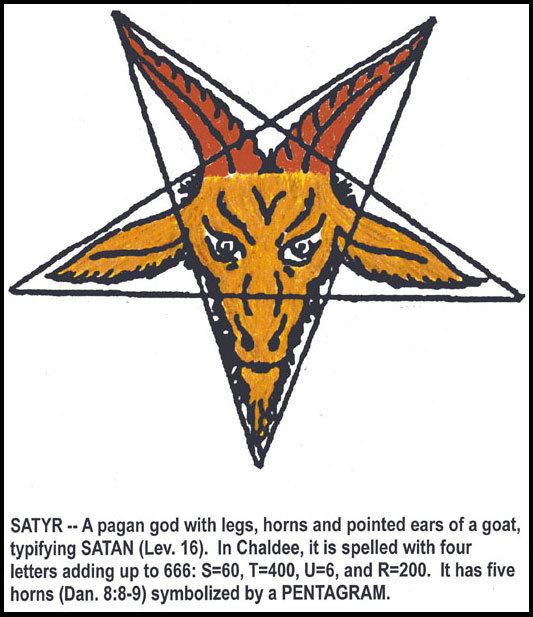
24 He will become very strong, but not by his own power. He will cause astounding devastation and will succeed in whatever he does. He will destroy the mighty men and the holy people.
The Caliphs were not "by his own power" -- not Mohammed's own flesh and blood descendants (cp. Dan. 8:22,24). Since the Caliphs were elected, and not in hereditary descent from Mohammed, the phrase "not with his own power" -- not his own descendants -- is used in Daniel 8:24. "And he shall ... destroy ... the people of the saints" (8:24). Gibbon records that the northern coast of Africa is the only land in which the light of the Gospel, after a long and perfect establishment, has been totally extinguished" (Gibbon 5:380). Gibbon says that "since the first conquests of the Caliphs, the establishment of the Turks in Anatolia or Asia Minor was the most deplorable loss which the church and empire sustained" (Gibbon 6:25).
25 He will cause deceit to prosper, and he will consider himself superior. By peace he shall destroy many: he shall also stand up against the Prince of princes; yet he will be destroyed, but not by human power.
"By peace ("Salama" or Islam) he shall destroy many" (Dan. 8:25). Moslems believe it is not necessary to keep treaties with infidels and so use "crafty deceit." "But he shall be broken without (human) hand" (Dan. 8:25). The Caliphate of Baghdad was undermined by luxury. Both the Arab and Turkish Empires collapsed as a result of internal corruption. Quarrels over the Caliphate resulting in the rival Umayyaid and Abassid Dynasties as well as Islam splitting into Sunni and Shia sections caused the collapse of the Arab Empire. Gibbon confirms that "The use of fraud and perfidy, of cruelty and injustice, were often subservient to the propagation of the (Islamic) faith" (Gibbon 5:274). In particular, he mentions that Mohammed is called "the Comforter" (Gibbon 5:239). This arrogant blasphemy seems to be a fulfillment of Daniel's words, "And in his own mind he shall magnify himself" (8:25). "By peace he shall destroy (corrupt) many" (8:25, RSV). Moslems obtain converts by offering peace to those who accept their religion. "The Koran, the tribute or the sword" were the options given to all converts. The corruption of many by offers of peace is nothing other than implementing Mohammed's command to propagate his false religion by the sword. The word "Islam" actually means "peace." "He shall even rise up against the Prince of princes; but by no human hand shall he be broken" (8:25). The Moslem creed places Mohammed above Jesus. Both the Arab and Ottoman Empires collapsed from internal dissention rather than external aggression. "The great schism between Sunni and Shia Muslims, and the subsequent fragmentation of the Caliphate which began with the secession of Spain under the Umayyads when the Abbasids overthrew the former in the east" (E. Atiyah, The Arabs, p.45, Penguin 1958). J. J. Saunders adds that, "Racial jealousy and disharmony may be accounted one of the principal causes of the disintegration of the Caliphate which followed swiftly on the overthrow of the Omayyads" (History of Medieval Islam, p.104, 1965). "Political decay and collapse everywhere under the relentless pressure of the western powers, whose science, industry and technology gave them temporarily the mastery of the world, and what was more serious, a challenge to Islamic fundamentals on the intellectual plane" (Saunders, ibid. p.202). The Turkish Sultan-Caliph was not defeated by external aggression, but was removed in 1922 and the office itself abolished in 1924, by the Turkish government under Mustafa Kemal (Ataturk).
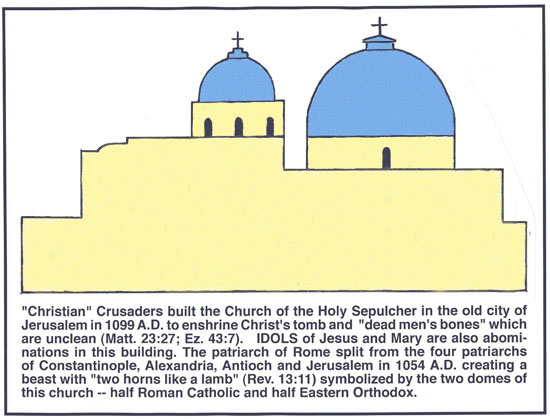
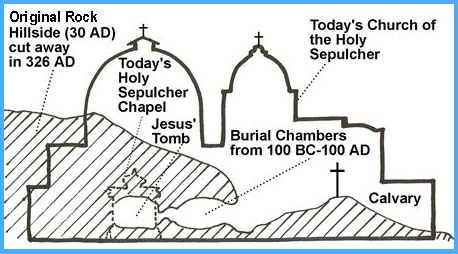
4. The Roman Catholic Papacy was the "Christian" "Little Horn" Fulfilment of Daniel 8
A fourth Abomination that desolated was the "Christian" Crusaders from Rome who built the Church of the Holy Sepulcher in Jerusalem in 1099 A.D. which still stands today. (Italian Church in Greek adds up to 666). IDOLS of Jesus and Mary are the Abominations in this building. The patriarch of Rome split from the FOUR patriarchs of Constantinople, Alexandria, Antioch and Jerusalem in 1054 A.D. How can Papal Rome be both the little horn of the FOUR-horned shaggy GOAT and also the little horn of the red DRAGON? Because the Eastern GREEK Orthodox church existed within the Roman Empire and fathered the Roman Catholic Church. It is interesting that Diocletian later divided the Roman Empire into FOUR CONTEMPORANEOUS PARTS called prefectures. They were 1.) the East, 2.) Illyricum, 3.) Gaul and 4.) Italy (Rev. 6:8). Out of one of these four -- namely Italy -- came forth the Papal horn.
The Pagan Greek Empire and Moslem Arab-Turkish Empire form one set of 2300 YEARS. Within the Roman Empire, the Byzantines and Eastern Greek Orthodox/Roman Catholic Church form another set. Each empire has a small and a large fulfillment. Antiochus (Greek) and Titus (Roman) fulfill 2300 DAYS persecuting JEWS while Moslems and Roman Catholics fulfill 2300 YEARS persecuting both JEWS and CHRISTIANS. The Dome of the Rock for Moslems and the Church of the Holy Sepulcher for the Catholics and Orthodox are the two Abominations. We don't know yet how to figure the 2300 evenings and mornings for the Church of the Holy Sepulcher.
Saint-worship, Virgin Mary-worship and superstition accompanied the Greek Orthodox and Roman Catholic churches (Rev. 9:20-21). First the Arabs tormented them, though they did not destroy them politically. Then the Turks were allowed to overthrow the Greek Byzantine empire after there was no repentance. Other Christians resisted the Moslem heresy and were persecuted.
Just as Antiochus conquered south, east and toward the glorious land, so also did Islam conquer south, east and toward the glorious land.
Just as Antiochus persecuted the Greek apostate Jews, so also Islam persecuted idolatrous Greek Christians.
Just as Antiochus placed an idol of Zeus and a pig on the altar, so Islam placed the Dome of the Rock on the Temple mount.
Just as
Greece and Islam's desolation lasted 2300 YEARS according to Daniel 8:14, so also Antiochus's desolation lasted 2300 DAYS.
Just as Allenby conquered Jerusalem from Turks in Kislev 24, 1917, so also the Maccabbees conquered Jerusalem from Greek Antiochus in Kislev 24, 165 B.C. Both thereby fulfilling Haggai 2:18-19: "From the four and twentieth day of the ninth month (Kislev 24) ... I will bless you."
Just as Charles Martel ("the Hammer") defeated the Arabs against enormous odds in 732 A.D. at Tours, so the Jewish Judas Maccabeas ('the Hammer") defeated the Syrians against enormous odds in 165 B.C.
Just as Antiochus came before Christ's first coming, so also the Anti-Christ will come before Christ's second coming (Matt.24:15) and be a fifth Abomination.
Just as Titus persecuted the Jews who rejected Christ, so also Papal Rome persecuted Christians who rejected the law and Jews who rejected Christ.
Just as Roman soldiers placed a golden eagle idol and a pig abomination on the altar, so Roman Catholic and Greek Orthodox crusaders conquered Jerusalem in 1099 A.D. and built the Church of the Holy Sepulcher in the old city of Jerusalem containing idols of Mary and Jesus and corpse abominations.
Whereas Daniel 8 skips over the intervening years from Alexanders four generals until the rise and fall of Islam, chapter 11 continues the story of the king of the north and south in greater detail until the First World War.
The Abomination of Desolation
We have seen four "ABOMINATIONS that DESOLATE" so far. As our Lord said, "when ye shall see Jerusalem compassed with ARMIES, then know that its DESOLATION is near" (Luke 21:20). The Greek armies of Antiochus who took away the Temple furnishings, broke them in pieces and carried them off to their own country are one; the Roman armies of Titus that burned Herod's Temple to the ground are two; the Moslem armies of Caliph Omar that built the Dome of the Rock in the place where the temple once stood are three; and Catholic crusaders took Jerusalem and built the Church of the Holy Sepulcher which is four. In addition to the physical destruction that each army caused, we know that Antiochus Epiphanes sacrificed a pig to Jupiter Olympus and sprinkled PIG'S blood in the Holy of Holies (1 Macc.6:7; 2 Macc.6:2). The Roman legions carried their standards, the EAGLE and the SERPENT (both unclean) into the Temple and sacrificed before them in the traditional Roman manner -- an ox, a sheep, and a PIG (unclean) -- hence ABOMINATION. The Moslem Dome of the Rock enshrines a rock in the center of the dome. This is the spot from which MUHAMMAD supposedly ascended for a night-long journey to heaven in AD 621, accompanied by the angel Gabriel. There he supposedly met many prophets like Abraham and Moses and was given the Islamic prayers before returning to Earth. It is interesting that when Greece controlled Syria, there was a Greek abomination soon after. When Rome controlled Syria, there was a Roman abomination soon after. When Moslems controlled Syria, there was a Moslem abomination soon after. Therefore, perhaps the abomination always came from the power controlling Syria.
Messiah the Fulfillment
It is interesting that Jesus' ministry began Tishri 15 and ended Nisan 14, a period of three and a half years also. Jesus ministry lasts 1260 days (3.5 years). It ended Passover, the day of His death. It so happens that 1150 days after the start of his ministry in Sukkot is the first day of Hanukkah
(on the 360 calendar) AD 27, Tisri 15-22, plus 1150 days = the 7 days of lights of Hanukkah, (AD 30, Kislev 24-Tibet 1[2]), plus the remaining 110 days that make AD 31, Passover (Nisan 14-21). This actual 1150 days into his ministry is the only place in the Bible where the Festival of Lights is mentioned in John 10:22. What an amazing "coincidence."
If the 3.5 years are 1260 days, then the final 1335th day occurs on Pentecost, "Blessed is he that waits and reaches to the 1335th day, (Daniel 12). Just as Antiochus killed and offered an unclean swine on the altar which was desecration of God's stone Temple, so the Jews killed and offered Jesus which was a desecration of God's Temple of flesh -- a worse sin then that of Antiochus -- a type of the Antichrist to come. All this fulfilled Daniel 9:24-27.
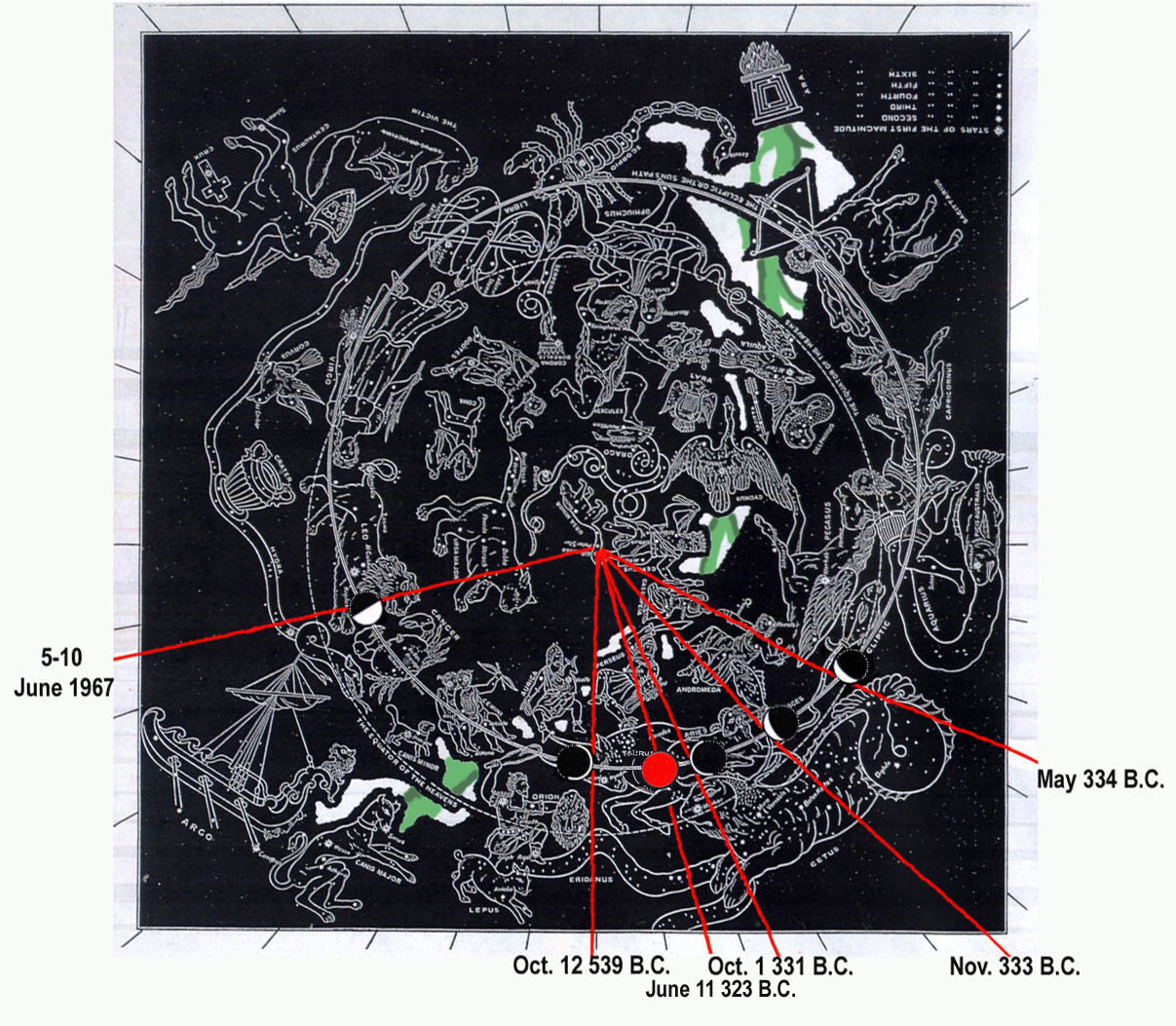
Chapter 8 Star Chart: From the fall of Babylon to the Medes and Persians 12 Oct. 539 B.C. we add 2460° months (205 years) going clockwise more than six laps around to arrive at the Battle of Granicus in May 334 B.C. when Alexander crossed into Asia and defeated the Medo-Persian army. Notice the phalanx formation on the Zodiac star chart with lunar shields and red radius line spears. The four heads of the leopard are the four crescent moons. "I looked up and saw a ram (Taurus) standing at the side of the (Granicus River in Asia Minor; Pinarus River at Issus both represented by Eridanus or Milky Way) River. The ram (Taurus) had two long horns ... one horn was longer than the other horn. The long horn was farther back than the other horn" (Dan. 8:3; ERV). Or "one of these horns began to grow, so that it was longer than the other" (TLB). The top horn of Taurus is being described. The goat (Aries) had a notable horn (lunar crescent and horn of Cetus forming the outlines of a massive horn) between his (Cetus') eyes.
|
|---|